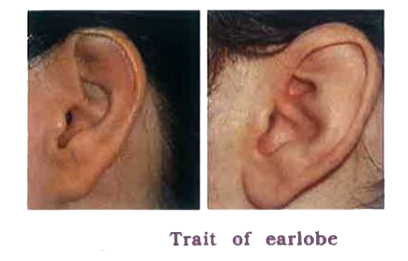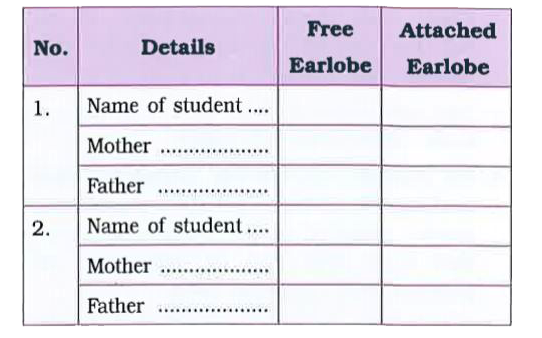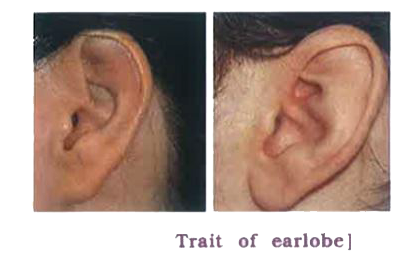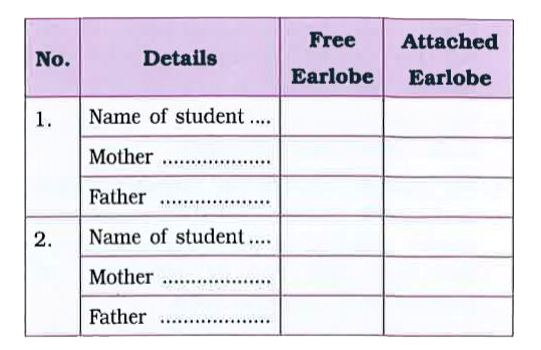To suggest rule for inheritance of earlobe type. Procedure /Method :
→ The lowest part of the ear pinna called the earlobe, is closely attached to the side of the head, i.e., attached or not, i.e., free.
→ Observe the earlobes of all the students in the class. Prepare a list of students. Enter the data about the earlobes whether they are free or attached.
→ Find out about the earlobes of the parents of each student in the class.
→ Correlate earlobe type of each student with that of their parents.
→ In the column write F for free earlobe and A for attached earlobe.


Answer the following questions on the basis of the collected data:
From your collected data state which expression is dominant and which one is recessive for earlobe.Solution in Gujrati
Free earlobe is dominant and attached earlobe is recessive expression.
Topper's Solved these Questions
- BOOK - KUMAR PRAKASHANCHAPTER - HEREDITY AND EVOLUTIONEXERCISE - TEXTUAL EXERCISE12videos
HEREDITY AND EVOLUTION
- BOOK - KUMAR PRAKASHANCHAPTER - HEREDITY AND EVOLUTIONEXERCISE - ADDITIONAL QUESTIONS AND ANSWERS18videos
HEREDITY AND EVOLUTION
- BOOK - KUMAR PRAKASHANCHAPTER - CONTROL AND COORDINATIONEXERCISE - PRACTICAL SKILL BASED QUESTIONS WITH ANSWERS8videos
CONTROL AND COORDINATION
- BOOK - KUMAR PRAKASHANCHAPTER - HOW DO ORGANISMS REPRODUCE?EXERCISE - PRACTICAL SKILL BASED QUESTIONS WITH ANSWERS5videos
HOW DO ORGANISMS REPRODUCE?
Similar Questions
A Mendelian experiment consisted of breeding tall pea plants bearing violet flowers with short pea plants bearing white flowers. The progeny all bore violet flowers, but almost half of them were short. This suggests that the genetic make-up of the tall parent can be depicted as ……..... a. TTWW b. TTwW c. TtWW d. TtWw
08:55View SolutionDistinguish between :
Acquired characteristics and Hereditary characteristics02:12View SolutionFour different students of your class observed network of neurons in a slide under microscope. They drew a diagram of synaptic junction.
From your knowledge.
Which of the following figures shows the correct pathway for the conduction of impulse ?View SolutionCollect different flowers such as Maize, Sunflower, Papaya, Hibiscus, Datura, Rose, Crinum, etc. Which of them are bisexual ? Draw diagram of any one bisexual flower and state function of each parts.
02:09View SolutionIn human, attached earlobes are a dominant feature over free earlobes while hypertrichosis (Y-linked) feature. A man with attached earlobed and extensive hair on pinna married a woman having free earlobes. The couple had one son with free earlobes and hairy pinna and two daughters with attached earlobes. One of the daughters with attached earlobes. One of he daughters married a man with free earlobes and sparse hair on pinna. They had two sons. What would be the characteristics of their ponnae ?
View SolutionGiven below is a pedigree chart of a family with five children. It shows the inheritance of attached earlobes as opposed to the free ones. The squares represent the male individulas and circules the female individuals. Which one of the following conclusions drawn is correct?
View SolutionThe earlobe variants found in human population are
(i) free. (ii) curved (iii) round. (iv) attached.01:55View SolutionTo suggest rule for inheritance of earlobe type. Procedure /Method : rarr The lowest part of the ear pinna called the earlobe, is closely attached to the side of the head, i.e., attached or not, i.e., free. rarr Observe the earlobes of all the students in the class. Prepare a list of students. Enter the data about the earlobes whether they are free or attached. rarr Find out about the earlobes of the parents of each student in the class. rarr Correlate earlobe type of each student with that of their parents. rarr In the column write F for free earlobe and A for attached earlobe. Answer the following questions on the basis of the collected data: Which expression of earlobe is observed more in number in your class?
01:36View SolutionTo suggest rule for inheritance of earlobe type. Procedure /Method : rarr The lowest part of the ear pinna called the earlobe, is closely attached to the side of the head, i.e., attached or not, i.e., free. rarr Observe the earlobes of all the students in the class. Prepare a list of students. Enter the data about the earlobes whether they are free or attached. rarr Find out about the earlobes of the parents of each student in the class. rarr Correlate earlobe type of each student with that of their parents. rarr In the column write F for free earlobe and A for attached earlobe. Answer the following questions on the basis of the collected data: Are the types of earlobes hereditary?
04:37View SolutionTo suggest rule for inheritance of earlobe type. Procedure /Method :
→ The lowest part of the ear pinna called the earlobe, is closely attached to the side of the head, i.e., attached or not, i.e., free.
→ Observe the earlobes of all the students in the class. Prepare a list of students. Enter the data about the earlobes whether they are free or attached.
→ Find out about the earlobes of the parents of each student in the class.
→ Correlate earlobe type of each student with that of their parents.
→ In the column write F for free earlobe and A for attached earlobe.


Answer the following questions on the basis of the collected data:
Determine the percentage of free earlobe and attached earlobe in the students of your classroom.03:18View SolutionWhat is earlobe ? Which are dominant and recessive variants respectively ?
03:58View SolutionYou observed trait of earlobe whether they are free or attached in four different couples, along with their children.
Couple has all the children with free ear- lobe even mother has attached earlobe. What do you think about father's earlobe ?02:01View SolutionYou observed trait of earlobe whether they are free or attached in four different couples, along with their children.
Couple has children with 1:1 ratio for free and attached earlobe. What do you think about their father-mother for this trait ?01:53View SolutionYou observed trait of earlobe whether they are free or attached in four different couples, along with their children.
In a couple, both father and mother have attached earlobe. What do you think about their children ?02:05View SolutionYou observed trait of earlobe whether they are free or attached in four different couples, along with their children. A couple has four children, out of which three have free earlobe and one has attached earlobe. What do you think about their parents ?
01:42View Solution

